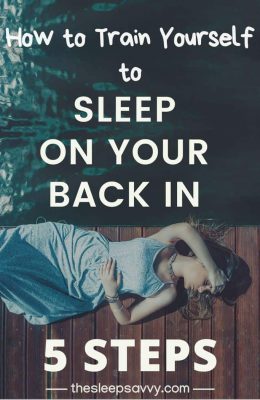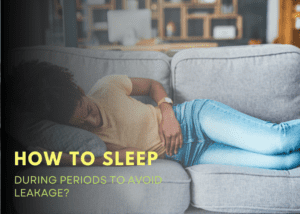We hope you love the product we recommend! Just so you know, at no extra cost to you, we may get a small commission for purchases made through links in this post. Your support is appreciated. Enjoy the read!
You probably shift around throughout the night, but have one position you like to sleep in.
Mine’s on my stomach.
Which is BAD, so I’ve been told. Most healthcare professionals recommend sleeping on your back.
How do you go about changing a habit that you’ve had for the last 20, 40 or even 60 years?!
It’s hard – not going to lie – but possible and never too late if you want to change.
It took some work but I consistently sleep on my back now. I’d like to share with you some tips and tricks on how to train yourself to sleep on your back!
First, let’s go over the different sleeping positions so we have a better understanding of how each one is good and bad for us.
The 3 Main Sleep Positions
Sleeping on Your Stomach
The Good
- Helps with digestion - I find this to be very true!
- Reduces symptoms of sleep apnea and prevents snoring
The Bad
- Causes neck pain when you turn your neck to the side
- Possibly suffocate and die if you don’t twist your neck - almost happened to me
- Wipes expensive moisturizer off your face and onto the pillow
- Pressure on your joints and muscles from misaligned spine
- Potentially leads to pain, soreness, numbness and tingling
I’m surprised this sleeping position isn’t more popular – only 7% of the population prefer to sleep like this – but I know I’m bias.
Sleeping belly down is good for cutting out the snoring but the negatives far outweigh any benefits it can bring. It’s arguably the worst position to sleep in for the many reasons listed above.
Even for massages, I’m wary of places that do not have elevated massage tables where there is a hole I can put my face when lying face down. Instead, they’d ask me to twist my neck to the side.
Good thing I don’t stumble on these places very often. When I do, I usually just walk right out. Usually, a proper massage table is an essential part of a Licensed Massage Therapist’s toolbox.
Unfortunately, this IS my favorite position to sleep in and I do indulge from time to time, especially when my stomach isn’t feeling very well.
I don’t stay in it for too long – usually during the first 10-20 minutes of falling asleep. Then I turn over on my back to fall and stay asleep.

By the way, I wasn’t kidding when I said you can suffocate and die if you sleep face down.
Here’s my near-death experience:
I was 7.
We were still living in our old family home.
We just got back home from swimming at the local community center that night.
I quickly passed out on my bed with my face going right into my pillow. I was just too tired to move.
It became hard to breathe.
To the point where my breathing slowed and I wasn’t able to inhale anymore. I remember thinking that I could die if I stayed in this position for much longer.
Finally, my instincts took over and I muscled up any remaining strength I had and turned to my side to save my own life.
And that’s how I became…a superhero!!
Sleeping on your tummy is recommended for people who have sleep apnea or snores.
However, it does come with a lot of downsides like waking up with pain and burning a hole through your wallet with all the chiropractic sessions you’ll need to go to.
Overall, I don’t advocate for this sleep style, even though I like to indulge once in a while.
SAVVY TIP:
There are a few ways you can make this posture better for you, but I still wouldn’t recommend staying in it for too long.
- Use a small pillow or one of those travel neck pillows (you know, the ones you see everyone and their dog use on airplanes) under your forehead so you can keep your neck straight and in line with the rest of your spine.
- Put a soft, flat pillow under your stomach to avoid pressure on your lower back. My chiropractor advised me to do this, and it does make a difference.
Again, I only stay in this position for 20 minutes max, and I usually turn my neck to the other side about halfway through to even out the strain.
Sleeping on Your Back
The Good
- Helps keep neck, head, and spine in a neutral position
- No pressure on shoulders or spine as body weight is evenly distributed
- Reduces and prevents wrinkles - no premature aging here!
- Keeps the expensive facial cream on your face
- Helps with acid reflux, less heartburn
The Bad
- Makes sleep apnea worse - tongue can block breathing tube
- Promotes snoring

This is the second least popular position – only about 8% of the population sleep like this – but it’s the BEST for your overall health.
Why?
Well, because it’s the most neutral position that you can keep your body in throughout the night.
If you keep yourself well-aligned, then you won’t wake up to any aches and pains!
It’s just like Savasana (dead body pose in Yoga) or like the guards at Buckingham Palace. Lie down on your back to the mattress with your arms out on the side.
Besides waking up with no pain, you’ll experience less heartburn because your stomach isn’t in a position where the acid can go back up your esophagus AND you won’t age as fast.
I know, we all want to be young forever.
This is no fountain of youth, but sleeping on your back will prevent premature wrinkles.
How?
Because you’re not squishing your face into the pillow for hours on end. Makes sense?

Starfish Pose
When I sleep on my back, I like to fan out my limbs and fully embracing the mattress-hogging person that I am.
This pose is so named ‘The Starfish’ because it looks exactly like – you guessed it – a starfish.
It has the same benefits as the standard back sleeping position but is a bit more comfortable (in my opinion).
Try it out and see for yourself.
Can I Sleep on My Back While I’m pregnant?
Some ladies and concerned hubbies might be wondering this.

Of course, consult your doctor first, but 9.99 times out of 10, the answer is NO.
Especially while you’re in the second and third trimester.
Why?
For a few reasons. According to Parents.com,
“the weight of your uterus can compress a major blood vessel, called the vena cava. This disrupts blood flow to your baby and leaves you nauseated, dizzy, and short of breath.
Yikes, that doesn’t sound good!
If you do wake up belly-up, that’s probably fine. Just change positions when you catch yourself and don’t do it regularly for a long period of time.
Try sleeping on your LEFT side instead.
Why?
Read about it below!
Sleeping on your back is recommended for…everyone!
If you’re not pregnant and don’t want to wake up with any pain, this is the way to go.
You may snore more and it probably wouldn’t help with your sleep apnea, but there are many solutions on the market that you can try.
SAVVY TIP:
You can sleep on your back without a pillow! Just make sure that your body is properly aligned to avoid any soreness when you wake up.
There’s actually an up and coming community out there that advocate sleeping on the floor and without a pillow.
Sleeping on Your Side
The Good
- Reduces symptoms of sleep apnea and snoring
- Helps with heartburn and digestion
- Ideal position for pregnant women for comfort and circulation (left side)
- Great for cuddling and pillow talk
The Bad
- Premature wrinkling due to pushing your face into the pillow
- Promotes a saggy chest (for the ladies) due to gravity
- Encourages numbness in shoulder or arms
- Wipes off one side of your face cream
This is the most comfortable position, about 41% the US population sleep this like, and is the second-best position to sleep in.
Sleeping on your side actually counts as two positions because there are two sides – your right and left.
Commonly referred to as ‘sleeping like a log’, this posture is when you’re on your side and your limbs are straight.
The Fetal Position
A variation of sleeping on your side is the fetal position, where your knees are higher and tucked into your stomach.
This pose may bring back feelings of safety and warmth, like when you were still in your mother’s womb, but it doesn’t do too much.
In fact, besides the same benefits as sleeping on your side, there are a few downsides to the fetal position.

If you curl up too tightly, you can restrict diaphragm breathing and feel sore the next morning.
The unnatural arch in your lower back throughout the night might flare up your joints, neck or spine, especially if you have arthritis.
So, unless it’s super comfortable to you, try not to get into that position.
Or at least don’t stay in that position for the entire night.
Sleeping on Your Left Side is Better
How come? That sounds so random.
It’s not.
The answer lies in human anatomy.
Our internal organs are arranged in a unique way where the stomach, pancreas and spleen are on the left side.
So, when you sleep on your left, your body isn’t working extra hard to fight gravity while circulating blood, digesting and keeping stomach acid from coming up your esophagus.
That makes sense, right?
Being on your right side seems to have the opposite effects.
Sleeping on your side also helps with snoring and sleep apnea, because your tongue wouldn’t be falling back towards your throat, blocking your airway.
If you got the height of your pillow right too, then there’s no pressure on your spine or neck.
Here’s an explainer video that tells it better than me!
I Sleep with 5 Pillows. This is Why You Should Too!
No joke – I actually do sleep with at least 4 pillows.
One for my head, 1-2 under my knees and for my legs, and one on each side of me.
My favorite is a full-length body pillow, so I can wrap my arms and legs around it while I’m sleeping on the side.
There was a time when I wondered if I ever needed a mattress.
I’m glad that silly phase is behind me.
If you’re worried about not being well-aligned enough, watch this video and try sleeping with a few more pillows.
This lady recommends three:
- between your knees to prop up your top hip and prevent from collapsing inwards.
- under your torso so you aren’t mushing your bottom shoulder with your body weight.
- in front of you or under your arm so you can hug it! Actually, it’ll keep your top shoulder from caving in, but hugging something feels nice too.
Sleeping on the side is also recommended for everyone!
Especially for people who have sleep apnea or snores, are in the 2nd or 3rd trimester of their pregnancy (left side only), or suffers heartburn.
A note for people with back/hip pain:
- Always consult your doctor first. They’ll most likely say that staying in one place for a long time is the worst thing you can do for recovering.
- But, of course, everyone needs to sleep. And properly resting on your side is probably good for you.
Side sleeping is not for people who want to look older by prematurely aging with wrinkles, are worried about a saggy chest or have shoulder pain.
What’s The Best Position to Sleep In?
Most health professions will say that the best sleeping position for almost everyone is on your back. (But on your left side if you’re with a child.)
But you knew that already, right? (…I also kind of said it earlier.)

Why is that?
There are many studies out there that have researched, experimented and concluded that sleeping on your back is just better for your overall health and body.
- The chance of you waking up with a crick in the neck or any soreness is pretty low.
Your body is naturally well-aligned while on your back, and because your body weight is distributed evenly, there isn’t any extra pressure on sensitive parts, like the neck, spine or back.
- Reduce heartburn because there’s less of a possibility that stomach acid will come back up through your esophagus.
This is also due to your body being properly aligned.
- No premature wrinkles from crushing one side of your face on the pillow or into the mattress on a regular basis.
Speaking of premature aging, the ladies also don’t have to worry about early on-set saggy breasts.
- According to the Global Burden of Disease study, lower back pain is the leading cause of disability around the world.
What’s fascinating about this is that we have full control over it! Back pain is not brought on by severe medical conditions like cancer, diabetes or arthritis.
Instead, it’s caused by stress on the body from sitting at a desk all day with your back hunched over, leading a sedentary lifestyle or even just sleeping in ergonomically-bad positions night after night.
These are things you can change starting tonight. So, are you going to learn how to train yourself to sleep on your back?
How to Train Yourself to Sleep on Your Back in 5 Easy Steps
- Prepare your body for a long period of not moving. Try doing some yoga or relaxation exercises right before bedtime. Add in some light stretches when you wake up.
- Use positioning pillows to keep you from turning to your side or stomach.
I find that a pillow on each side and one under the knee helps my spine stay aligned throughout the night.
Or a wedge pillow that elevates my head and neck keeps me in place.
If those props don’t work, try placing a golf ball in your pants or shirt pocket. Sleeping on one will be uncomfortable enough to make you turn back.
- Consciously think about it. Tell yourself you’re going to stay on your back as you fall asleep. Visualize yourself staying and waking up on your back and say it out LOUD. Communicating this to your subconscious mind will make it stick more.
- Catch yourself and reposition. It’s OK. No one’s perfect. You probably will mess up in the first few days or even weeks! Just keep correcting your position when you catch yourself.
- Reward yourself along the way. Maybe it’s an extra 10 minutes soaking in the tub or taking a class you’re interested in. It can be anything – just make sure it won’t lead to disruptive behavior.
As with forming any habit, the key is to be a) patient with yourself, and b) persistent. You just have to keep doing it until it one day becomes second nature.
There’s a theory floating around that it takes 21 days to form a habit.
That’s actually NOT true.
The original concept was that it takes AT LEAST 21 days, but for most people, that’s too short of a time frame to do much.
In a more recent study, the researchers found that it took an average of 66 days to get into the groove – that’s slightly over 2 months.
Sounds about right!
Regardless of these numbers, the most important thing to remember is that introducing something new to a routine is going to be difficult.
So take it one day at a time.
It’s even harder when you’re unconscious and unaware of what you’re doing, but hopefully, it’s easier by following this guide.
Yes, it’ll be hard. Yes, it’ll feel unnatural at first. Yes, you’d probably fail many times in the beginning.
But, BOY, will it be worth it!
Final Thoughts
Sleep on your back, duh!
Just kidding!
I’m not going to tell what to do here. I mean, it’s your body after all.
Remember that your overall comfort is the most important thing and every body is different.
Just make sure your neck, spine, and back are supported properly so you don’t start the next day with any pain. Your future-self will thank you!
If you do want to give it a try, this “how to train yourself to sleep on your back” guide will be here waiting for you!
*Click here to learn more about how your body works: thesleepsavvy.com/resources/
>> Looking for the best mattress for pregnancy? Read more<<
The new versions are nothing like the originals!







